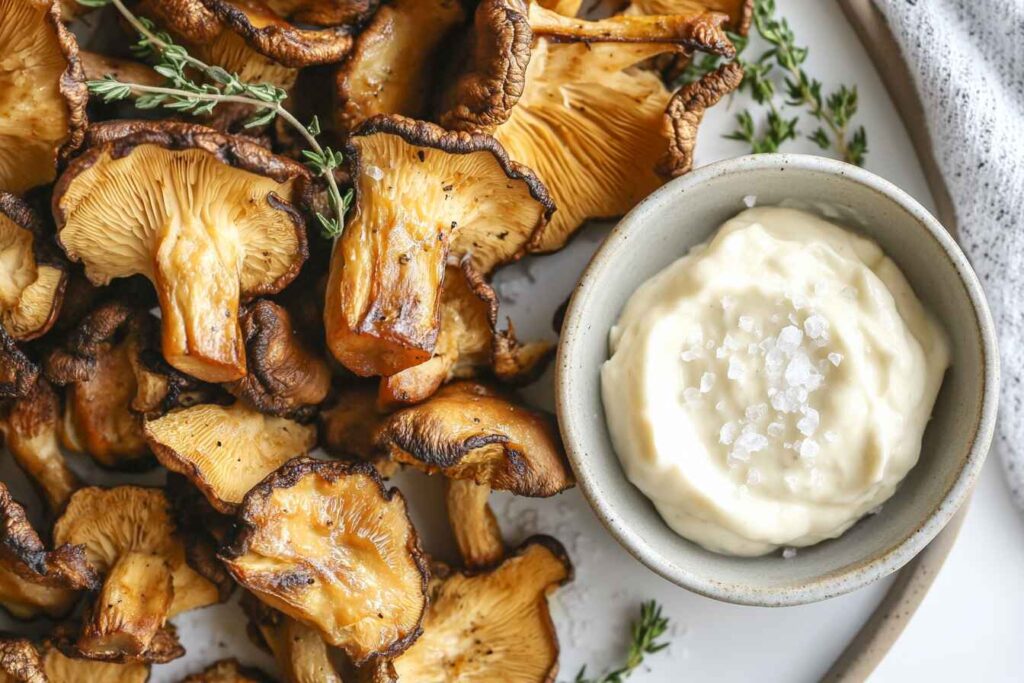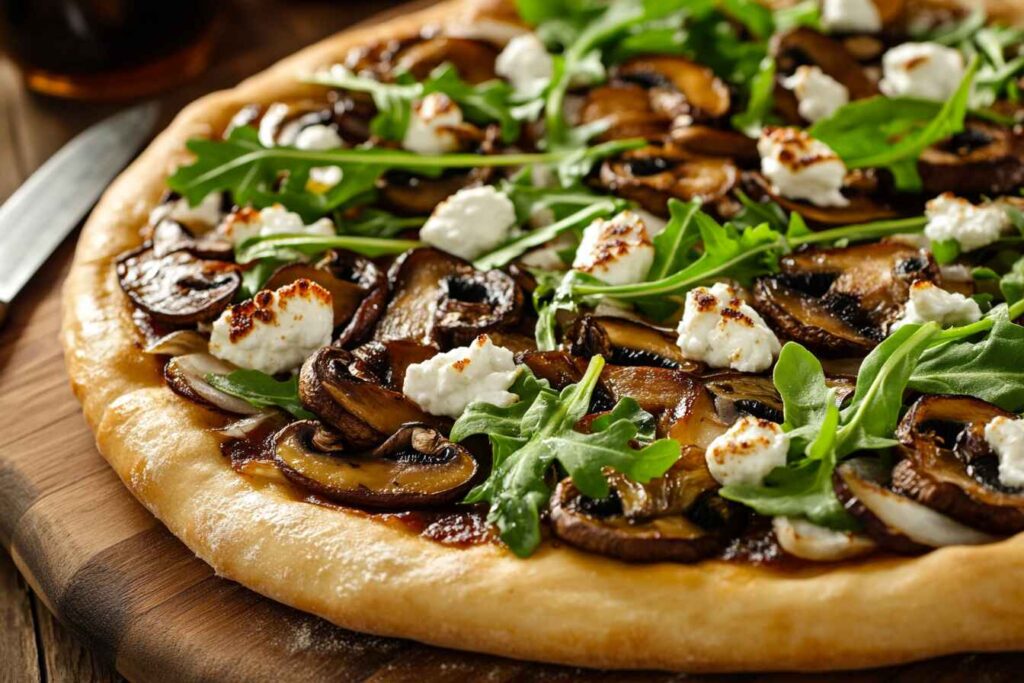Introduction

Have you ever come across a mushroom so unique that it instantly caught your attention? That’s exactly what happens when you discover maitake recipe mushrooms, also known as Hen of the Woods. Their delicate, feathery appearance and earthy flavor make them a favorite among food enthusiasts and chefs alike.
Whether you’re a mushroom lover or just curious about incorporating them into your meals, this guide will show you how to prepare maitake mushrooms, explore their benefits, and provide some mouthwatering recipes. Let’s dive into the world of maitake and learn why they deserve a place in your kitchen! 🍄
What Are Maitake Mushrooms?
The Origins and History of Maitake Mushrooms
Maitake mushrooms, or “dancing mushrooms” in Japanese, are native to Japan, China, and North America. They grow at the base of hardwood trees, forming clusters that resemble a hen’s feathers—hence the name “Hen of the Woods.”
Traditionally, maitake mushrooms have been prized in Asian cultures for their medicinal properties. They were believed to bring longevity and vitality, making them a staple in both cuisine and medicine.
What Does Maitake Taste Like?
Maitake mushrooms have a flavor profile that’s earthy, nutty, and slightly peppery. When cooked, they develop a meaty, umami-rich taste that pairs well with various ingredients. Imagine the depth of a portobello mushroom but with a lighter, more delicate texture.
If you’re new to mushrooms, maitake is a great entry point—they’re flavorful without being overpowering. They also soak up seasonings beautifully, making them versatile in the kitchen.
The Health Benefits of Maitake Mushrooms
What Does Maitake Do for the Body?
Maitake mushrooms aren’t just delicious; they’re a powerhouse of nutrients! They’re packed with vitamins like B and D, along with minerals such as potassium and selenium.
Here’s how they benefit your body:
- Boost Immunity: Maitake mushrooms contain beta-glucans, which support immune health.
- Regulate Blood Sugar: They may help stabilize blood sugar levels, making them a great choice for those with diabetes.
- Rich in Antioxidants: These help fight oxidative stress and reduce inflammation.
Nutritional Breakdown of Maitake Recipe
| Nutrient | Amount (per 100g) |
|---|---|
| Calories | 31 |
| Protein | 1.9g |
| Fiber | 2.7g |
| Vitamin D | 112% of RDI |
| Potassium | 204mg |
Low in calories but high in nutrients, maitake mushrooms are a guilt-free addition to any meal.
For more nutrient-dense options, try our Dense Bean Salad—a refreshing side dish that pairs well with any meal.
Common Myths About Maitake Recipe
- Myth: Maitake mushrooms taste bitter.
Truth: If cooked properly, they have a mild, earthy flavor with no bitterness. - Myth: Maitake mushrooms are only for fancy dishes.
Truth: They’re versatile and work in everything from soups to stir-fries.
How to Cook Maitake Mushrooms
Preparation Tips: Cleaning and Cutting Maitake Mushrooms
Before you start cooking, you need to prep your maitake mushrooms:
- Cleaning: Use a damp paper towel to gently wipe away dirt. Avoid soaking them in water, as they can absorb moisture and become soggy.
- Cutting: Trim the base where the mushrooms are attached and separate the clusters into smaller pieces.
What Is the Best Way to Prepare Hen of the Woods?
The best way to prepare maitake mushrooms is to keep it simple and let their natural flavor shine. A quick sauté with garlic and olive oil is often all they need. You can also roast them in the oven to bring out their crispy edges and rich umami flavor.
Cooking Methods: Sautéing, Roasting, and Stir-Frying Maitake
- Sautéing: Heat olive oil or butter in a skillet, add minced garlic, and toss in the mushrooms. Cook for 5-7 minutes until golden brown.
- Roasting: Preheat the oven to 400°F (200°C). Toss maitake with olive oil, salt, and pepper, and roast on a baking sheet for 15-20 minutes.
- Stir-Frying: Add the mushrooms to a hot wok with vegetables and soy sauce for a quick and flavorful side dish.
Pair these cooking techniques with side dishes like Cucumber Kimchi for an exciting mix of textures and flavors.
How Do You Eat Maitake?
You can enjoy maitake mushrooms in countless ways:
- Add them to soups or stews for an earthy depth of flavor.
- Use them as a topping for pizzas or flatbreads.
- Incorporate them into pasta dishes or risottos for a gourmet touch.
Block Quote:
“Maitake mushrooms are like a culinary chameleon—they adapt beautifully to whatever dish you’re preparing!”
Maitake Recipe Ideas
Maitake mushrooms are incredibly versatile, making them a fantastic addition to a variety of dishes. Here are some must-try recipes that are easy to prepare and guaranteed to impress your taste buds.
Simple Sautéed Maitake with Garlic and Butter
This classic recipe highlights the natural flavor of maitake mushrooms.
Ingredients:
| Ingredient | Quantity |
|---|---|
| Maitake mushrooms | 200g |
| Butter | 2 tbsp |
| Garlic, minced | 2 cloves |
| Salt and pepper | To taste |
| Parsley (optional) | For garnish |
Instructions:
- Heat a skillet over medium heat and melt the butter.
- Add the garlic and sauté until fragrant.
- Toss in the maitake mushrooms and cook for 5-7 minutes, stirring occasionally, until golden and tender.
- Season with salt and pepper. Garnish with parsley before serving.
Pro Tip: Pair this with a steak or serve as a topping for mashed potatoes.
Maitake Mushroom Risotto
Creamy, rich, and packed with umami, this risotto is a showstopper.
Ingredients:
| Ingredient | Quantity |
|---|---|
| Maitake mushrooms | 150g |
| Arborio rice | 1 cup |
| Chicken or vegetable stock | 4 cups |
| Onion, finely chopped | 1 small |
| Garlic, minced | 2 cloves |
| Parmesan cheese, grated | ½ cup |
| Olive oil | 2 tbsp |
Instructions:
- Heat olive oil in a pan and sauté onions and garlic until soft.
- Add the rice and toast for 1-2 minutes.
- Gradually add stock, one ladle at a time, stirring until absorbed. Repeat until rice is cooked.
- Sauté the maitake mushrooms separately and fold them into the risotto.
- Stir in Parmesan cheese and serve immediately.
Crispy Roasted Maitake as a Snack or Side Dish (H3)
This recipe is perfect for crispy, flavorful bites that can double as a snack or a side.
Ingredients:
| Ingredient | Quantity |
|---|---|
| Maitake mushrooms | 200g |
| Olive oil | 2 tbsp |
| Salt and pepper | To taste |
Instructions:
- Preheat your oven to 400°F (200°C).
- Toss the mushrooms with olive oil, salt, and pepper.
- Spread them on a baking sheet in a single layer.
- Roast for 15-20 minutes, flipping halfway through, until crispy.
Pro Tip: Sprinkle some smoked paprika or chili powder for an extra kick!
Common Problems When Cooking Maitake Mushrooms and Solutions
Even though maitake mushrooms are easy to cook, a few common problems might pop up. Here’s how to handle them:
Mushrooms Turning Soggy: How to Avoid It
- Problem: Maitake mushrooms can release water and become soggy if cooked incorrectly.
- Solution: Avoid overcrowding the pan. Cook them in batches over medium-high heat to allow moisture to evaporate quickly.
Overcooking Maitake: How to Retain Texture and Flavor
- Problem: Overcooked maitake mushrooms can become rubbery and lose their flavor.
- Solution: Cook them for 5-7 minutes max when sautéing or roasting. Keep an eye on them, as they cook faster than denser mushrooms.
Incorporating Maitake into Everyday Dishes
- Problem: Unsure how to use maitake in regular meals?
- Solution: Add them to omelets, stir them into soups, or mix them into pasta sauces for an instant flavor boost.
Block Quote:
“The trick to mastering maitake mushrooms is to keep things simple and let their natural flavor shine.”
Maitake Mushrooms in Modern Cuisine

Maitake mushrooms aren’t just a hit in traditional recipes; they’ve found their way into modern kitchens, becoming a staple for creative and innovative dishes. Whether you’re dining at a high-end restaurant or experimenting at home, maitake adds a gourmet touch to any meal.
Why Chefs Love Maitake Mushrooms
Maitake’s versatility and rich umami flavor make it a favorite among chefs worldwide. It pairs beautifully with meats, pastas, and grains, while its unique texture holds up well in various cooking methods. Plus, its feathery appearance adds a visual flair to any dish.
Creative Uses for Maitake Mushrooms
If you’re looking to push culinary boundaries, here are some inventive ways to use maitake:
- Maitake Tacos: Roast maitake mushrooms with taco seasoning and serve them in warm tortillas with avocado and lime.
- Maitake Pizza: Use roasted maitake mushrooms as a topping along with goat cheese and caramelized onions.
- Maitake Tempura: Dip small clusters in tempura batter and fry for a light, crispy appetizer.
- Maitake Burgers: Mix sautéed maitake mushrooms into your burger patties for added moisture and flavor.
Pro Tip: Maitake mushrooms are an excellent meat substitute for plant-based dishes. Their meaty texture makes them perfect for vegetarian and vegan recipes.
How to Store and Preserve Maitake Mushrooms
Storing maitake mushrooms properly is essential to maintain their flavor, texture, and freshness. Whether you’ve purchased them fresh from the market or foraged them yourself, the right storage methods will ensure they stay delicious for your next recipe.
Storing Fresh Maitake Mushrooms
To keep your maitake mushrooms fresh, follow these simple steps:
- Clean Carefully: Avoid washing them with water before storage. Instead, gently brush off any dirt or debris with a damp paper towel. Too much moisture can cause them to spoil quickly.
- Wrap Loosely: Place the mushrooms in a paper bag or wrap them loosely in a kitchen towel. This allows airflow and prevents them from becoming slimy.
- Refrigerate Immediately: Store them in the vegetable crisper drawer of your refrigerator. Maitake mushrooms can stay fresh for up to a week if properly stored.
Pro Tip: Never store mushrooms in plastic bags, as this traps moisture and accelerates spoilage.
Preserving Maitake Mushrooms for Long-Term Use
If you have more maitake mushrooms than you can use within a week, don’t worry! There are effective ways to preserve them:
- Freezing Maitake Mushrooms:
- Clean and slice the mushrooms.
- Sauté them lightly in olive oil or butter to preserve their flavor.
- Let them cool completely, then transfer to an airtight freezer bag.
- Frozen maitake mushrooms can last up to six months.
- Drying Maitake Recipe Mushrooms:
- Use a dehydrator or an oven set at a low temperature to dry the mushrooms.
- Once completely dried, store them in an airtight container in a cool, dark place.
- Rehydrate them by soaking in warm water before cooking.
Why Proper Storage Matters
Taking a few extra steps to store your maitake mushrooms properly ensures you can enjoy their full flavor and texture whenever you’re ready to cook. Plus, it reduces food waste and saves you a trip to the store.
With these storage tips, you’ll always have fresh or preserved maitake mushrooms ready to enhance your meals! 🌟
FAQs About Maitake Mushrooms
What Does Maitake Do for the Body?
Maitake mushrooms are rich in beta-glucans, which support immune health and may help lower cholesterol levels. They also provide antioxidants that reduce inflammation and promote overall well-being.
Who Should Not Take Maitake Mushroom?
While maitake mushrooms are generally safe, people on blood-thinning medications or those with low blood pressure should consult their doctor before consuming them, as maitake may enhance these effects.
Does Maitake Increase Estrogen?
Maitake mushrooms do not directly increase estrogen levels. However, they are known to support hormonal balance in some cases. If you have concerns about hormone-related conditions, consult a healthcare provider.
How to Cook Maitake Mushrooms?
The best way to cook maitake mushrooms is by sautéing, roasting, or stir-frying them. Use simple ingredients like garlic, butter, or olive oil to enhance their natural umami flavor.
Conclusion: Why Maitake Should Be a Staple in Your Kitchen
Maitake mushrooms are a culinary treasure, offering a unique combination of flavor, health benefits, and versatility. From simple sautéed dishes to gourmet recipes like risotto, they can elevate any meal effortlessly. For more exciting recipes, visit our guide on Lamb Loin Roast Cooking to discover how to make your meals truly special.
So why not add maitake recipe mushrooms to your next grocery list? Give these recipes a try, and let their rich, earthy flavor transform your cooking! 🍄
